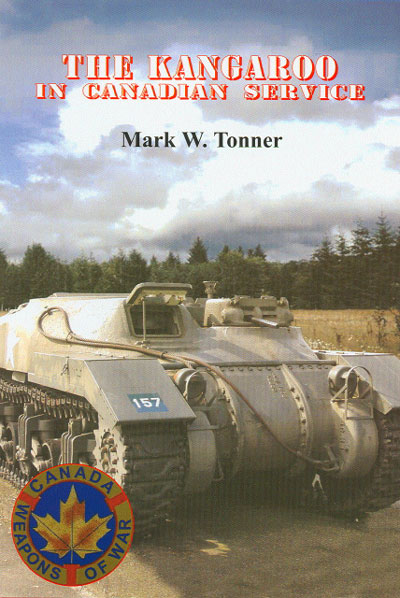The Kangaroo in Canadian Service
by Mark W. Tonner

"Weapons of War" Series; Service Publications, Ottawa, Ontario,
Canada, 2005; 24 pp. with B&W photos and one painting diagram; price
CDN $9.95; ISBN 1-894581-30-X (http://www.servicepub.com)
Advantages: in-depth coverage of a popular subject among Commonwealth
modelers and what amounts to the first operational fully-tracked APC
Disadvantages: lack of interior views and plans likely to disappoint some
modelers
Rating: Highly Recommended
Recommendation: for all Commonwealth and "mech infantry" fans
Up until the advent of the Kangaroo concept, fully-tracked armored personnel
carriers for the infantry had been seen as an unsupportable luxury. The
Soviets had a number of prototypes – one of which tried to carry
half a platoon of infantry stuffed into a box on a T-26 tank chassis!
– but nobody had fielded one.
The only ones in service had been thinly-armored halftracks, or later
on the partially armored US AMTRAC vehicles. These had both the dual problem
of thin armor and insuficient mobility to keep up with tanks cross country.
Lieutenant-General G. G. Simonds, GOC II (Canadian) Corps, was looking
for a good way to ensure that infantry could accompany the tanks into
combat. The Soviet – and American, and German – solution up
until this point had been to use "tank riders" on the backs
of the tanks themselves, but the troops were woefully vulnerable to artillery
and enemy small arms fire. Simonds figured that the best way to fight
fire was with fire; by using the more heavily armored M7 "Priest"
chassis, stripped of its gun and provided with a number of infantry inside
the casemate, could move with the tanks while providing better protection
to the infantry prior to close combat with the enemy.
Since the Commomwealth was in the process of phasing out the Priest with
its 105mm howitzer in favor of the Sexton with the 25-lber, the standard
Commonwealth field gun, there were extra Priest chassis with which to
experiment. Removing the howitzers and covering the opening with armor
plate welded in place, 72 were converted for use by the 2nd Canadian and
51st Highland Divisions during Operation TOTALIZE. The name came from
the codename for the conversion workshop, Advanced Workshop Detachment
"Kangaroo."
The results were very promising, as the infantry using the ad hoc APCs
were able to achieve their objectives with minimal losses. In September
the Canadians were told to give the Priests back to the Americans (after
reinstalling the 105mm howitzers) so the new standard vehicle of choice
was a conversion of the Canadian Ram tank. The Ram, a good idea when created,
had become undersized and obsolete for use against German armor, but was
perfectly suitable for this purpose as it had relatively heavy armor protection
(for an APC), a bow machine gun mount or turret, and most important of
all, parts and servicing compatibility with the M4 series of tanks then
in general service with both the US and Commonwealth forces.
Early Ram II tanks were permitted to keep their bow machine gun turret,
but most of the conversions were based on late-model ones with the hull
doors removed and a bow machine gun position instead; all were fitted
with UK No. 19 HF radio sets, and carried a crew of two and 10 infantry.
Two Kangaroo regiments – one Canadian (1st CACR), one British (49th
APCR) – were formed by October 1944, each with 106 Ram Kangaroos;
each regiment had two squadrons of 53 each, and four troops of 12 each
within the squadrons.
The book continues to cover the history of the 1st Canadian Armoured
Personnel Carrier Regiment in detail. A good number of photos of the Kangaroos
in action are included, but only one general plan of the vehicle is provided.
Happily it is of the "standard" or late-model Ram II chassis
based variant.
One major complaint modelers have about the Ram Kangaroo is –
what is inside it? Most sources tend to indicate – nothing! Apparently
the vehicles were not fitted with benches or stowage racks to any standard
pattern, and admittedly cramming ten men into a relatively small area
is not helped if there are sharp objects to dodge as well. However, they
apparently used every type of M4 track produced – the photos show
them with UK pattern steel chevron, T48, T49, and T51 with or without
"duckbill" extenders.
Thanks to Clive Law of Service Publications for the review copy.
Cookie Sewell
|